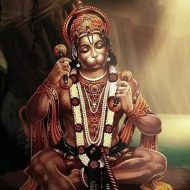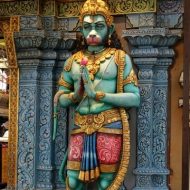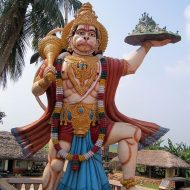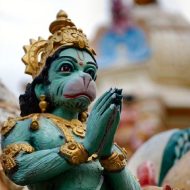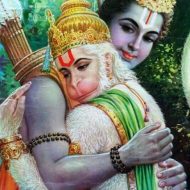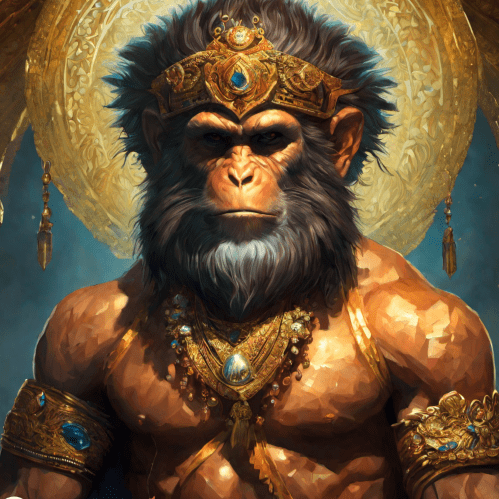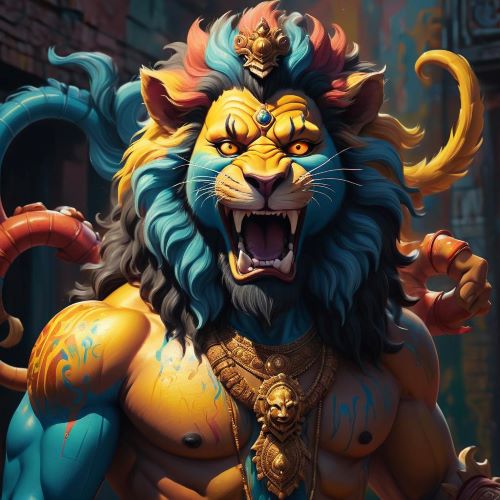Hanuman : The Monkey God
At a glance
| Description | |
|---|---|
| Origin | Indian Mythology |
| Classification | Hybrids |
| Family Members | Anjana (Mother), Kesari (Father) |
| Region | India |
| Associated With | Loyalty, Strength, Problem solving, Friendship |
Lord Hanuman : The Hindu Monkey God
Introduction
Hanuman, the mighty monkey deity characterized by immense strength, unwavering devotion, and boundless courage, occupies a revered position in Indian mythology. His significance extends beyond the borders of India, touching the hearts of millions worldwide. Interwoven with the epic Ramayana, Hanuman’s narrative encapsulates themes of loyalty, faith, and selfless service.
Born to the Vanara king Kesari and the celestial nymph Anjana, Hanuman assumes a pivotal role in the Ramayana. He is portrayed as a formidable warrior, a loyal friend and devoted servant to Lord Rama, embodying strength and steadfast determination. Hanuman’s reverence stems from his resolute allegiance to Lord Rama, his extraordinary bravery in confronting peril, and his complete surrender to his divine purpose.
One account states that when Anjana was worshipping Shiva, the king of Ayodhya Dashrath was also performing a puja which begot him with sons Rama, Lakshmana, Bharatha and Shatrughna. They were born when his wives consumed a pudding that was blessed by the Gods and passed onto them after the puja. A hawk snatched a portion of the pudding while it was being handed over and flew away with it. The wind god Vayu delivered the portion to the hands of Anjana who consumed it and was blessed with Hanuman as a child.
Physical Traits
Hanuman is often depicted as a large, muscular monkey with a fiery red face and a long, white tail. He possesses superhuman strength, speed, and agility. He can change his size at will, assuming massive forms or becoming as small as an insect. He is also said to possess the ability to fly and leap across vast distances. His image is further embellished with a crown, earrings, and a sacred thread, symbolizing his divine nature.
Family
Hanuman was born on the mountain Anjaneri. His mother Anjana was an apsara who was born on earth after suffering a curse. She was redeemed by giving birth to a son. The Ramayana states that his father, Kesari, was the king of a place called Sumeru. For 12 long years, Anjana and Kesari prayed for a son to Lord Shiva and was eventually blessed with a son.
He is also the son of Vayu, who in various stories played a crucial role in his birth. Another tradition says that Anjana and her husband Kesari prayed to Shiva for a child. By Shiva’s direction, Vayu transferred his male energy to Anjana’s womb. Accordingly, Hanuman is identified as the son of the Vayu.
Other Names
The origin of the word Hanuman is unclear. One interpretation is that it refers to a character with a mutilated jaw. This supports a Puranic legend where Hanuman, as an infant, mistakes the Sun for a fruit and makes a leap towards it. He is wounded in the jaw when he is thrown back to earth by the sun God.
Hanumat, Anuman, Hanumantha, and Hanumanthudu are some of the names that have linguistic variations of “Hanuman”. These names are often used in rural India. Anjaniyar, Anjaneyar, and Anjaneya are also used in Southern India to indicate that he is the son of Anjana.
Hanuman is known by various names, each reflecting a facet of his identity. As the Vayu Putra, he is recognized as the Son of the Wind God, emphasizing his divine parentage. Maruti is another appellation, indicating his connection to Maruta, an alternate name for the Wind God. Anjaneya, on the other hand, underscores his maternal lineage as the Son of Anj
Powers and Abilities
Hanuman is blessed with numerous gifts, powers and abilities but is also cursed with the fact that he is never aware of his powers. Hanuman is endowed with a multitude of extraordinary powers and capabilities. His strength is legendary, as tales speak of his ability to lift mountains and crush boulders effortlessly. Exhibiting superhuman speed, he can soar through the skies at velocities surpassing even the wind itself. His agility is further demonstrated by the remarkable skill to leap vast distances, covering miles in a single bound.
Blessed with immortality, Hanuman remains impervious to the effects of aging and death. Additionally, he possesses the unique ability to shapeshift, seamlessly altering his size and form as needed. Endowed with divine vision, he can perceive things hidden from ordinary sight. Hanuman’s linguistic prowess extends to understanding and speaking all languages, be they human or animal. Furthermore, his touch holds healing powers, with the capability to cure wounds and ailments.
Modern Day Influence
Hanuman as a deity has influence over Hinduism, Buddhism, Jainism, Sikhism and other traditional religions of South East Asia. He is seen in drawing and historical representations of various Asian cultures like Thailand, Indonesia, Sri Lanka and Cambodia.
He is also a common fixture of Ramlila celebrations and also has temples dedicated to him all over India.
Related Images
Frequently Asked Questions
What was Hanuman the god of?
Hanuman, not a god but a revered vanara (monkey god), embodies several noble qualities in Hindu mythology. His immense strength and courage, coupled with unwavering devotion to Lord Rama, make him a symbol of selfless service and unwavering faith. He serves as a role model for scholars, warriors, and devotees, inspiring people with his wisdom, self-discipline, and celibacy. As the son of the wind god, Vayu, he embodies the power of speed and agility, further enriching his multifaceted nature.
What is the real age of Lord Hanuman ji?
Lord Hanuman’s age is an enigma, shrouded in mythology and interpretations. Considered immortal (chiranjivi), some scriptures suggest his age is a staggering 4.32 billion years. Others attempt to estimate his age within human chronology, placing it around 4,000-5,000 years. However, some view his age symbolically, representing timeless devotion, strength, and wisdom, transcending the limitations of human time. Ultimately, his age signifies his enduring qualities and timeless existence in the hearts and minds of Hindus.
Does Hanuman have a child?
While revered as a Brahmachari (celibate) in the core Ramayana and most Hindu interpretations, some regional and modern narratives suggest Hanuman has a child named Makardhwaja. These stories, though outside the canonical texts, offer an alternative perspective on Hanuman’s nature, highlighting his nurturing and protective qualities. Ultimately, whether Hanuman has a child is open to interpretation, reflecting the diverse and evolving nature of Hindu mythology.
Where is Hanuman now in Kalyug?
The question of where Hanuman resides in the present age of Kalyug remains shrouded in mystery and faith. Some believe he dwells physically on Gandhamadana Mountain or in his ancestral home of Kishkindha, while others claim his presence exists within temples dedicated to him. However, many interpretations view Hanuman as omnipresent, existing everywhere where his name is chanted or his praises are sung. Ultimately, his presence in Kalyug transcends physical location, symbolizing eternal qualities of strength, devotion, and wisdom, offering inspiration to all who seek his guidance. Whether physically present or symbolically significant, Hanuman’s influence remains a powerful reminder of the enduring values he embodies.
Who is Hanuman's wife?
While the Ramayana portrays Hanuman as a celibate devotee, regional narratives and modern interpretations paint a different picture. Southern Indian tradition suggests he was married to Suvarchala, daughter of the Sun god, for symbolic reasons. Jaina texts offer a wife named Anangkusuma, focusing on a different aspect of Hanuman’s story. Folktales from various regions add additional wives and children, though their authenticity remains debated. Ultimately, the question of Hanuman’s marital status depends on the chosen interpretation and individual faith.


